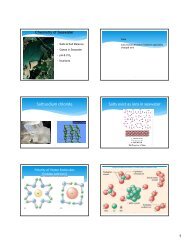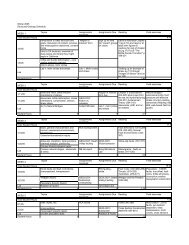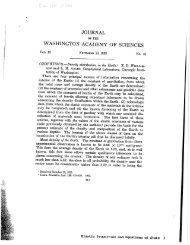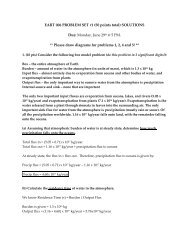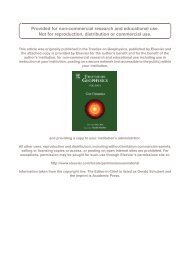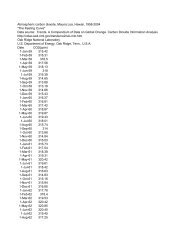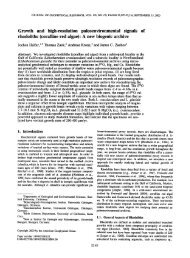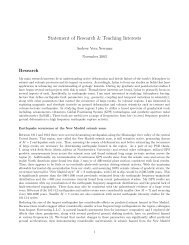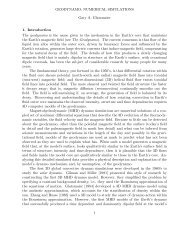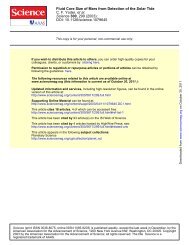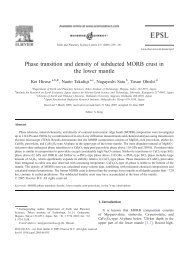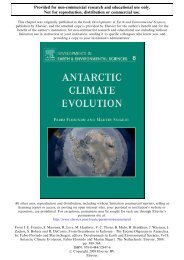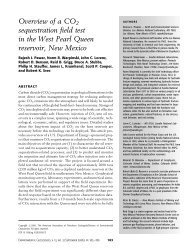08-0415 LECTURE.pdf
08-0415 LECTURE.pdf
08-0415 LECTURE.pdf
You also want an ePaper? Increase the reach of your titles
YUMPU automatically turns print PDFs into web optimized ePapers that Google loves.
CLADE<br />
CHORDATA<br />
Assorted jawless fish<br />
Urochordata &<br />
Cephalochordata<br />
Synapsids<br />
‘Amphibians’<br />
Most ‘fishes’<br />
1<br />
Pterosauria<br />
Archaic archosaurs &<br />
crocodiles<br />
Lepidosaurs<br />
Anapsids<br />
6<br />
5<br />
11<br />
AMNIOTA<br />
4 TETRAPODA<br />
3 GNATHOSTOMATA<br />
2 VERTEBRATA<br />
CHORDATA<br />
DERIVED TRAITS<br />
1. Bilateral, notochord + nerve cord, segmented muscles<br />
2. Big head with brain, bony skeleton<br />
3. True jaws<br />
4. Four weight-bearing limbs, neck, loss of gills, lungs<br />
5. Amniotic egg, thick skin, distinctive skulls<br />
6. One temporal fenestra, low<br />
7. Distinctive skull roof and neck vertebrae<br />
8. Two temporal fenestrae<br />
10<br />
ORNITHODIRA<br />
9<br />
ARCHOSAURIA<br />
8 DIAPSIDA<br />
7 REPTILIA<br />
9. Teeth in sockets, antorbital and mandibular fenestrae, rotating<br />
ankles<br />
10. Erect stance (90° angle at hip, knee in line with hip and foot),<br />
advanced metatarsal ankle<br />
11. Elongate digit IV + many flight specializations<br />
Dinosauria<br />
12. Three or more sacral vertebrae, perforate acetabulum, weight on<br />
middle toe, walk on toes<br />
12<br />
1
Basal archosaurs that aren’t dinosaurs (“thecodonts”)<br />
Herbivores<br />
Rhynchosaurs<br />
Carnivores<br />
Rauisuchians<br />
Aetosaurs Phytosaurs<br />
DERIVED TRAITS<br />
1. Bilateral, notochord + nerve cord, segmented muscles<br />
2. Big head with brain, bony skeleton<br />
3. True jaws<br />
4. Four weight-bearing limbs, neck, loss of gills, lungs<br />
5. Amniotic egg, thick skin, distinctive skulls<br />
6. One temporal fenestra, low<br />
7. Distinctive skull roof and neck vertebrae<br />
8. Two temporal fenestrae<br />
9. Teeth in sockets, antorbital and mandibular fenestrae, rotating<br />
ankles<br />
10. Erect stance (90° angle at hip, knee in line with hip and foot),<br />
advanced metatarsal ankle<br />
11. Elongate digit IV + many flight specializations<br />
12. Three or more sacral vertebrae, perforate acetabulum, weight on<br />
middle toe, walk on toes<br />
2
Lagosuchus<br />
Scleromochlus<br />
Scleromochlus<br />
Pterosauria<br />
Lagosuchus<br />
Ornithodira<br />
Why erect posture?<br />
Why erect posture?<br />
Carrier’s Constraint: side to side flexure in reptiles<br />
prevents simultaneous walking and breathing<br />
Dinosauria<br />
Pterosauria<br />
Dinosauria<br />
3
CLADE<br />
CHORDATA<br />
Assorted jawless fish<br />
Urochordata &<br />
Cephalochordata<br />
Synapsids<br />
‘Amphibians’<br />
Most ‘fishes’<br />
1<br />
Pterosauria<br />
Archaic archosaurs &<br />
crocodiles<br />
Lepidosaurs<br />
Anapsids<br />
6<br />
5<br />
11<br />
AMNIOTA<br />
4 TETRAPODA<br />
3 GNATHOSTOMATA<br />
2 VERTEBRATA<br />
CHORDATA<br />
10<br />
ORNITHODIRA<br />
9<br />
ARCHOSAURIA<br />
8 DIAPSIDA<br />
7 REPTILIA<br />
Dinosauria<br />
SHARED, DERIVED CHARACTERS OF THE DINOSAURIA<br />
sacrum with 3 or more fused vertebrae<br />
reduced toes, weight on middle toe<br />
Foot postures<br />
pubis<br />
ilium<br />
12<br />
perforate<br />
hip socket<br />
ischium<br />
Astragalus<br />
fused to tibia<br />
4
1887<br />
Locomotions<br />
Mono: Mammals<br />
Synapsid<br />
amniotes<br />
Ancestral<br />
Vs<br />
Derived<br />
Para: Reptiles<br />
Mono: Birds<br />
5
Lagosuchus<br />
Theropoda<br />
DINOSAURS?<br />
1887 - 1984: Polyphyletic<br />
Herrerasaurus, Staurikosaurus<br />
Prosauropoda<br />
Saurischia<br />
Theropoda: carnivorous, bipeds<br />
Sauropoda: herbivorous,<br />
quadrupeds<br />
Sauropoda<br />
Lesothosaurus<br />
Saurischia<br />
Anklylosauria<br />
Dinosauria<br />
Stegosauria<br />
Ceratopsia<br />
Marginocephalia<br />
Ornithischia<br />
Pachycephalosauria<br />
Thyreophora Cerapoda<br />
Prosauropoda:<br />
herbivorous, bipeds to<br />
quadrupeds<br />
Ornithopoda<br />
6
Ornithischia<br />
Thyreophora: Stegosauria and Ankylosauria: herbivores, quadruped<br />
to facultative biped, stuff on their backs<br />
Marginocephalia: Ceratopsia and Pachycephalosauria: herbivores,<br />
bipeds to quadrupeds, stuff on their heads and necks<br />
Ornithischia<br />
Ornithopoda: herbivores, bipeds to facultative quadrupeds<br />
Coelophysis<br />
Herrarasaurus<br />
Eoraptor<br />
Pisanosaurus<br />
Staurikosaurus<br />
Saltopus<br />
Azendohsaurus<br />
Alwalkeri<br />
prosauropods<br />
220-230 Ma<br />
7
Ischigualasto Plain, Argentina<br />
Lagosuchus<br />
Dinosaur-like archosaur<br />
Last seen: South America<br />
235-240 my<br />
Herrerasaurus:<br />
Argentina<br />
~3 m long<br />
8
Saurischia - Theropoda:<br />
Eoraptor<br />
Ornithischia:<br />
Pisanosaurus<br />
Coelophysis bauri<br />
THE BIG FIVE<br />
PHANEROZOIC<br />
MASS EXTINCTIONS<br />
9
MASS EXTINCTIONS<br />
Large number of species terminated<br />
Species terminated globally<br />
Extinctions happen over relatively short time<br />
period<br />
CONS<br />
Heavy species and family<br />
losses<br />
Long-term ecologic collapse<br />
The ‘One-Two’ Punch<br />
Low sea level<br />
Carbon cycle changes<br />
PROS<br />
Opportunity for mass<br />
evolutionary<br />
diversification<br />
Late Triassic Mass Extinction<br />
FEATURES<br />
2-phases?<br />
Sea level fall<br />
Effusive volcanism (central Atlantic magmatic province)<br />
2<strong>08</strong>-213 my<br />
Shocked quartz<br />
Widespread wildfires?<br />
24-45% of all families; 60-80% of all species?<br />
DINOSAUR EXPANSION<br />
CAUSES?<br />
Volcanism?<br />
Oceanographic changes?<br />
Asteroid impact?<br />
10
Manicougan impact crater<br />
diversity<br />
blueprint<br />
established<br />
small, bipedal,<br />
unspecialized<br />
carnivores<br />
214 my<br />
few million years<br />
*percentage dinosaur species<br />
Dinosaurs<br />
outcompeted other<br />
land vertebrates in<br />
the late Triassic<br />
Dinosaurs were<br />
lucky survivors<br />
60%<br />
6%<br />
Rhaetian<br />
213 205 my<br />
219 210 my my<br />
Norian<br />
221 225 my<br />
Carnian<br />
227 231 my<br />
Ladinian<br />
43 miles<br />
Times of mass extinction<br />
11
A long period of<br />
co-existence<br />
between<br />
dinosaurs and<br />
their ancestors<br />
TAKE HOME:<br />
Sterling Nesbitt<br />
FIRST DINOS SMALL, BIPEDAL, UNSPECIALIZED<br />
CARNIVORES, SPREAD QUICKLY<br />
RELATIVE ABUNDANCE AND MAJOR DIVERSITY<br />
ESTABLISHED BY END OF TRIASSIC, WITH A<br />
LITTLE HELP FROM A COUPLE OF ECOLOGICAL<br />
DISASTERS<br />
12
Walking with dinosaurs, New Blood segment<br />
Brings to life many of the vertebrate groups we’ve been<br />
discussing<br />
Many sad stories (not Disney)<br />
Depicts a drought episode preserved at the Ghost Ranch site<br />
Animals to look out for:<br />
Placerias – a dicynodont synapsid (mammal-like reptile)<br />
Cynodont – another synapsid, very mammal-like reptile<br />
Postosuchus – a rauisuchian archosaur diapsid (upright)<br />
Peteinosaurus – an early pterosaur (ornithodiran), a<br />
European import, all the way from the Italian Alps<br />
Coelophysis – a theropod saurischian dinosaur<br />
Plateosaurus – a prosauropod, saurischian dinosaur<br />
Metoposaurus<br />
(amphibian)<br />
Stagonolepis (an aetosaur,<br />
herbivorous archosaur)<br />
Phytosaurus<br />
(carnivorous archosaur)<br />
13



